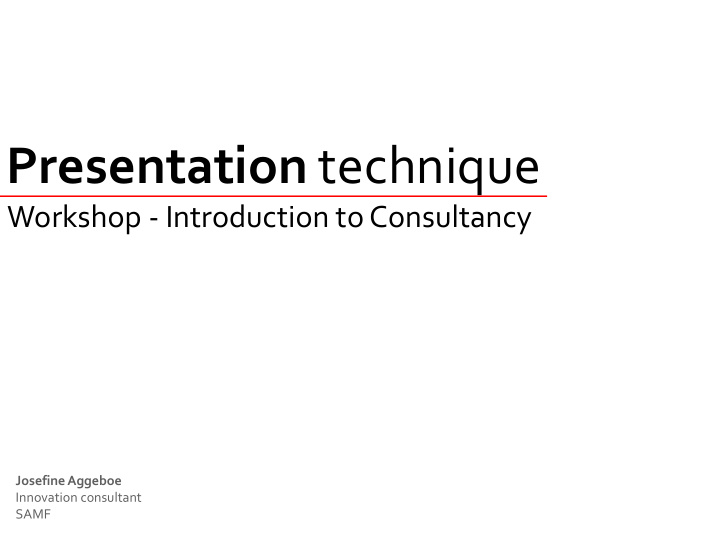



Presentation technique Workshop - Introduction to Consultancy Josefine Aggeboe Innovation consultant SAMF
Agenda - Presentation technique – preparation, content and performance - Group work – feedback and hands on experience
Presentation technique Preparation, Relation and Performance (Greve, 2010: Den gode præsentation)
Preparation Five phases: • Invention (brainstorm, listen, curiosity) • Disposition (message, progression, argumentation) • Tone of voice (appeal, language, ethos) • Memory (this is when you make power points) • Action (performance, evaluation, learning)
NABC and Toulmin Create and deliver superior customer value (Carlson and Wilmot, 2006: Innovation – The five disciplines for creating what customers want, Toulmin, S, 1958 (2003): The uses of argument)
NaBC N eed - What are the customer and market needs? A pproach - What is your unique approach for addressing this need? B enefit - What are the specific benefits for the stakeholders? C ompetition - How are the benefits superior to the competition and the alternatives?
Needs (N) Overall question: What is the specific need for your idea? • Based on your knowledge of the field, how do you see the problem • Which stakeholders are affected by the problem and who are you focusing on Be specific and visual: use drawings and (if possible) photos from your research
Approach (A) Overall question: How does your idea solve the needs identified Communicate your concept, which might be a system, a product, a service, a process (or a combination): • System/proces visualization • User scenario (e.g. for an employee or end-user/consumer) • Prototypes • Role play
Approach (A) – prototyping and user scenarios E.g AppSeed app, A floor plan and a paper A photobooth system for a ‘Prototyping on Paper’ prototype of a visitation board dep. of dermathology
Benefits (B) Overall question: What are the benefits of your concept for the partner and the end users? • Does it save time or money? • What are the emotional benefits? • What are the benefits for the different stakeholders? Be as specific as possible when communicating the benefits of your concept – use numbers, facts, statements and visuals
Competition (C) Overall question: What and who competes with your concept? • How does your concept differ form the competitors’ • Does your partner know the competitors? • What are the alternatives to implementing your concept? Be sure to think about the possible objections the partner may have to your concept – how are to what extend are you going to incorporate the partner’s feedback to your concept?
The Toulmin Model of Argument
Relation • Purpose • Context and frame • Who is in the audience – how do you handle feedback and questions? • Ethos
Performance • Language, voice and body language • Interacting with the audience and mirroring • Visuals and props • Nerves
Template for presentation
Practice • Prepare your presentation – max 10 minuts • Present to another group – 10 minuts + feedback (5+10 minuts) • Switch roles • Revise your presentation
Thanks
Recommend
More recommend